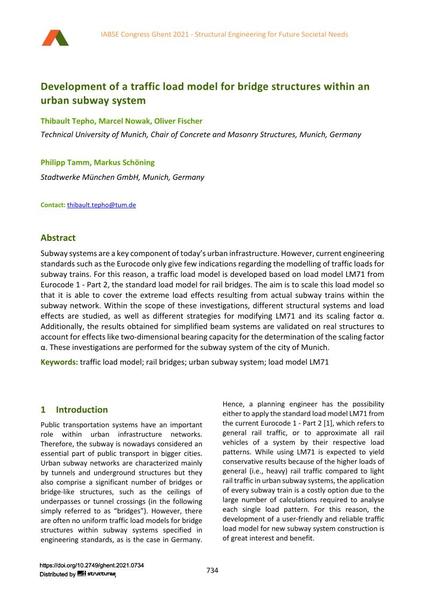Development of a traffic load model for bridge structures within an urban subway system

|
|
|||||||||||
Bibliographic Details
| Author(s): |
Thibault Tepho
(Technical University of Munich, Chair of Concrete and Masonry Structures, Munich, Germany)
Marcel Nowak (Technical University of Munich, Chair of Concrete and Masonry Structures, Munich, Germany) Oliver Fischer (Technical University of Munich, Chair of Concrete and Masonry Structures, Munich, Germany) Philipp Tamm (Stadtwerke München GmbH, Munich, Germany) Markus Schöning (Stadtwerke München GmbH, Munich, Germany) |
||||
|---|---|---|---|---|---|
| Medium: | conference paper | ||||
| Language(s): | English | ||||
| Conference: | IABSE Congress: Structural Engineering for Future Societal Needs, Ghent, Belgium, 22-24 September 2021 | ||||
| Published in: | IABSE Congress Ghent 2021 | ||||
|
|||||
| Page(s): | 734-740 | ||||
| Total no. of pages: | 7 | ||||
| DOI: | 10.2749/ghent.2021.0734 | ||||
| Abstract: |
Subway systems are a key component of today’s urban infrastructure. However, current engineering standards such as the Eurocode only give few indications regarding the modelling of traffic loads for subway trains. For this reason, a traffic load model is developed based on load model LM71 from Eurocode 1 - Part 2, the standard load model for rail bridges. The aim is to scale this load model so that it is able to cover the extreme load effects resulting from actual subway trains within the subway network. Within the scope of these investigations, different structural systems and load effects are studied, as well as different strategies for modifying LM71 and its scaling factor α. Additionally, the results obtained for simplified beam systems are validated on real structures to account for effects like two-dimensional bearing capacity for the determination of the scaling factor α. These investigations are performed for the subway system of the city of Munich. |
||||
| Keywords: |
railroad bridges rail bridges traffic load model urban subway system load model LM71
|
||||
| Copyright: | © 2021 International Association for Bridge and Structural Engineering (IABSE) | ||||
| License: | This creative work is copyrighted material and may not be used without explicit approval by the author and/or copyright owner. |
||||
